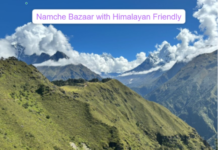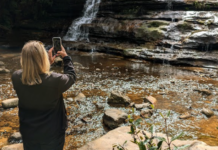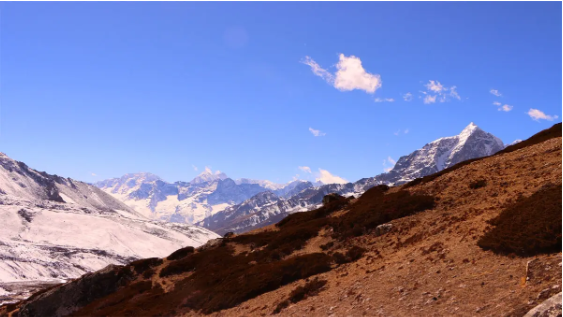Mera Peak (6,476 meters / 21,247 feet) stands as one of the highest trekking peaks in Nepal, offering a thrilling yet accessible mountaineering challenge for adventure enthusiasts. Located in the Khumbu region, just southeast of Mount Everest, Mera Peak climbing provides stunning panoramic views of some of the world’s tallest mountains, including Everest, Makalu, Lhotse, and Cho Oyu. While Mera Peak is not as technically demanding as other Himalayan giants, it offers a unique and rewarding experience for those who wish to test their mountaineering skills at high altitudes.
The Route and Climbing Experience
The Island Peak Climbing expedition begins in Kathmandu, Nepal’s vibrant capital, where climbers meet their expedition team and finalize their preparations. After a scenic flight to Lukla, the trek heads into the Khumbu Valley, following a well-trodden trail through Sherpa villages, lush forests, and alpine meadows. Trekkers pass through Namche Bazaar, the bustling gateway to the Everest region, and the small village of Thangnak, where they begin their ascent toward Mera Peak Base Camp (5,300 meters).
The route to Base Camp takes climbers through the beautiful Hinku Valley, a quieter and less-visited area compared to the Everest Base Camp trek, providing a peaceful and pristine trekking experience. Climbers spend several days at Base Camp to acclimatize to the high altitude, ensuring that they can safely attempt the summit. From Base Camp, the route heads upward to High Camp (5,800 meters), where climbers prepare for the final push to the summit.
The final ascent to the summit is physically demanding but achievable for climbers with basic mountaineering skills. It involves navigating a glacier, climbing along snow slopes, and occasionally using fixed ropes. The climb requires the use of ice axes, crampons, and harnesses, and some sections may require technical climbing techniques. The summit day is typically early in the morning, as climbers aim to reach the top before the weather worsens.
Reaching the summit of Mera Peak is an exhilarating experience, with breathtaking views of the surrounding peaks. From the summit, climbers enjoy a 360-degree view that includes Everest (8,848 meters), Lhotse (8,516 meters), Cho Oyu (8,188 meters), Makalu (8,485 meters), and Kanchenjunga (8,586 meters), among others. The experience of standing atop Mera Peak, surrounded by the towering Himalayan giants, is both humbling and awe-inspiring.
Difficulty and Technical Skills
Mera Peak is considered a non-technical climb, making it an ideal choice for climbers with limited mountaineering experience. However, it is still a high-altitude climb, and altitude sickness is a significant concern. Climbers should be prepared for long days of trekking, demanding physical conditions, and the challenges of high-altitude mountaineering.
While Mera Peak is not as technically difficult as some other Himalayan peaks, it still requires basic climbing skills. Climbers need to be comfortable with the use of ice axes, crampons, and ropes, as well as understanding glacier travel. Most climbers on the Mera Peak expedition will be accompanied by experienced guides who provide expert instruction on climbing techniques, equipment use, and safety protocols.
Best Time to Climb
The best times to attempt Everest base camp trek are during the pre-monsoon (spring) and post-monsoon (autumn) seasons, typically from March to May and September to November. During these months, the weather is generally stable, with clear skies offering optimal visibility of the mountains. These months also provide more favorable trekking conditions, with less snow and rain, making the climb safer and more enjoyable. Winter and monsoon months are typically avoided due to heavy snow, low temperatures, and the higher risk of avalanches.

Cultural and Scenic Experience
Beyond the physical challenges of the climb, Mera Peak offers trekkers an opportunity to immerse themselves in the rich culture of the Sherpa people. As climbers pass through the remote villages of the Hinku Valley, they witness a way of life that has remained largely unchanged for centuries. The trek offers a unique chance to visit Buddhist monasteries, interact with locals, and learn about Sherpa customs and traditions.
The route to Mera Peak also provides some of the most breathtaking landscapes in Nepal. From lush rhododendron forests to stark, snow-covered ridges, the trek offers a variety of scenery, with views of towering peaks and glaciers at every turn. The quiet, unspoiled nature of the Hinku Valley makes this trek especially serene, providing climbers with a truly immersive experience in the Himalayas.
Conclusion
Gokyo lake Trek is an exceptional adventure for trekkers and climbers seeking to challenge themselves in the heart of the Himalayas. Offering accessible climbing conditions, stunning scenery, and cultural immersion, it provides an opportunity to stand atop one of the highest trekking peaks in Nepal. With the right preparation, training, and a spirit of adventure, summiting Mera Peak is a rewarding experience, allowing climbers to witness some of the most spectacular mountain views on Earth and gain a sense of accomplishment that will last a lifetime.


















